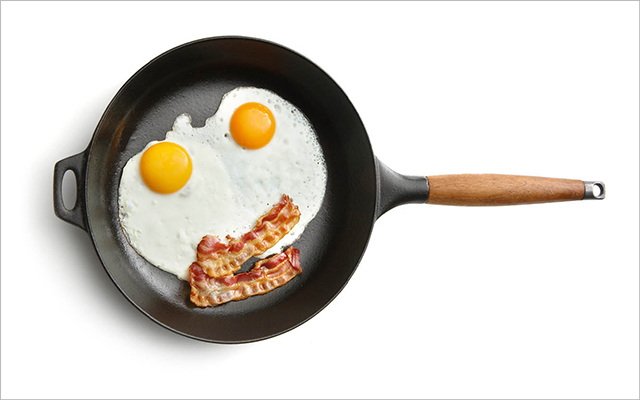If you had asked me last week what I recall about the late Jacqueline Kennedy Onassis, I would have replied like most anyone else: her pink pillbox hat, her pearls, her limousines and her yachts, and her tragic courage. O the glamour! O the heroism!
But after I read Rebecca Harrington’s book about rumored celebrity diets, I’ll Have What She’s Having: My Adventures in Celebrity Dieting, thinking about Jackie O just depresses the heck out of me.
This was a woman bullied by life into some seriously messed-up eating habits. During one of her weight-loss jags, for example, Jackie’s daily diet consisted of a single baked potato, stuffed with beluga caviar and sour cream. Harrington, in the great tradition of stunt journalism, samples this eating plan, and swiftly discovers she is too tired to concentrate through an entire movie in the evening.
“I have lost three pounds in two days. This is a very effective diet!” she reports. “I am also crazy now, however.”
Exploring documents penned by the late first lady’s housekeeper, Marta, Harrington learned that Jackie O eventually discovered the convenience of Lean Cuisine meals.
“According to Marta, ‘She couldn’t get over that you just had to put one in the oven, and after a short time you took it out, and there was everything, from soup to dessert. She thought that was great.’ I don’t know what this means,” writes Harrington. “Soup and dessert, all in one Lean Cuisine? Are we eating the same Lean Cuisines?”
Harrington investigates further: “I buy a Lean Cuisine mac and cheese and microwave it for lunch. A suspicious amount of water collects at the bottom of the tray — soup?”
Whatever I might have imagined Jackie O was up to during all those years I saw her staring out at me from the tabloids, the idea that she might have been starving in her luxurious Fifth Avenue apartment never crossed my mind.
To hear Harrington tell it, Jackie was the picture of health compared with Marilyn Monroe, who started her day with two raw eggs whipped into warm milk, then fasted until dinnertime, when she devoured steak, lamb, or liver alongside five carrots.
Harrington found this routine profoundly unsatisfying: After breakfast, she was hungry again within hours.
“I don’t actually eat dinner until 8 p.m.,” she writes, “when my friend and I feast on half a steak fillet and five raw carrots each. I am starving after dinner, as if I never ate it at all. Marilyn’s life was extremely hard.”
Harrington spends the next day faint with hunger, and the third so hungry she breaks down and eats dinner at three o’clock. “I feel very tired and heavy,” she notes. “Can’t tell if I’m losing weight. I suspect this is a diet one can only do while doing recreational barbiturates.”
Soon, she finds herself so woozy she nearly falls onto the subway tracks, and she can’t sleep at night because her stomach is so painful. Also, for those keeping track at home, she doesn’t lose any weight.
How much did this diet contribute to Monroe’s death at 36 of a barbiturate overdose? One can only guess.
Harrington’s book is full of frightening “diets,” which apparently have been a staple of celebrity life for most of the past century. Greta Garbo lived with her nutritionist, who devised ingenious recipes like puréed celery baked into loaves, and raw eggs beaten into orange juice. (“This is so much worse than the raw eggs in milk I drank for the Marilyn Monroe diet,” Harrington writes. “If pneumonia were a food, this is what it would taste like.”)
Garbo dieted during her entire American movie career — from the day in 1924 when studio bigwig Louis B. Mayer told her, “In America, men don’t like fat women,” to the day in 1941 when she retired at the ripe old age of 36. She then became a notorious recluse, avoiding any and all publicity.
“No wonder she ‘want[ed] to be alone’,” Harrington concludes, citing the star’s most famous line, from the film Grand Hotel. “She had to bear the pain of such an insane eating regimen without the impertinent attention of the world.”
Celebrities’ eating habits have not improved in modern times. Chanel and Fendi fashion designer Karl Lagerfeld lost 80 pounds in part by guzzling up to 10 cans of Diet Coke a day and grasping whatever nutrition he could from packets of protein powder.
Harrington tries this strategy herself: “After three [Diet Cokes] in quick succession, I get very jittery; after four, I decide I’m so jittery I can’t eat lunch (protein sachet) or write or concentrate and just start pacing my room, which seems, all of a sudden, like a necessary activity.”
Victoria Beckham, a.k.a. Posh Spice, once employed a diet in which she ate only five handfuls (palmfuls, really) of food each day.
Madonna goes in for a macrobiotic diet that includes breakfasts of steamed greens and a Fuji apple. (“I am basically dying on this diet,” writes Harrington.)
Dolly Parton has subsisted on a daily diet consisting primarily of a soup made from cabbage and tomatoes.
For the record, none of these approaches is a good idea. Bodies need nutrition. Brains and nerves are made of fats. The celebrities taunting us from the covers of supermarket tabloids who miraculously lost their baby weight likely did so through extreme dieting (and, in some cases, possibly surgery).
So why do we keep falling for these silly ideas? I’ve been aware for a long time that celebrities were doing the Master Cleanse, but I didn’t realize until I read Harrington’s book that it involves drinking cayenne-spiked maple lemonade and partaking in something called the Salt Water Flush.
Yes, virtual seawater. If you’re on a lifeboat lost at sea, you’re advised not to drink the ocean water, because your body can only excrete urine that is less salty than saltwater. So if you drink enough saltwater, you’ll just dehydrate and die.
Whenever I see women carting around jars of cayenne lemonade, I now wonder if they are leading secret lives as shipwreck victims.
Celebrities peer out at us from every grocery-store checkout line. The magazine headlines promise to disclose the celebs’ secrets to fame, fortune, and happiness, which in turn lead us to believe that their perfect bodies — and perfect lives — just come naturally.
Look more closely, though, and you’ll see that beneath the veneer of perfection are a lot of unhealthy and unsustainable eating habits. Harrington offers us a welcomed portrait of real celebrity life, one that rarely makes the cover of People.




This Post Has 0 Comments